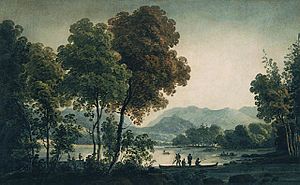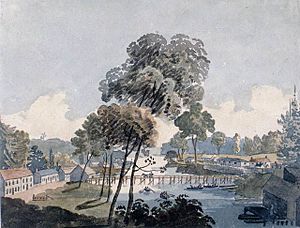George Heriot (artist) facts for kids
Quick facts for kids
George Heriot
|
|
|---|---|
| Born | 1759 Haddington, Scotland
|
| Died | 1839 (aged 42–43) |
| Known for | civil servant, author and artist |
George Heriot (born 1759 – died 22 July 1839) was an important Scots-Canadian civil servant, writer, and artist. He is best known as a key figure in the early history of Canadian art.
Contents
Early Life and Education
George Heriot was born in Haddington, Scotland, in 1759. He was the oldest child of John Heriot, who was the town's official record keeper. His family was well-known, and a famous relative was the 17th-century goldsmith and helper of others, George Heriot.
George went to school in Duns and Coldstream. From 1769 to 1774, he attended the Edinburgh Royal High School. There, he received a good education that focused on old languages and history. After high school, he stayed in Edinburgh and studied art. He was encouraged by Sir James Grant to pursue his artistic talents.
Travels and Military Training
In 1777, Heriot traveled to London, planning to start a career in art. However, he ended up on a journey to the West Indies instead. We don't know why his plans changed, but his family faced financial difficulties that year. While in the Caribbean, he wrote and sketched a lot. When he returned to London in 1781, he published a book of poems called A Descriptive Poem, written in the West Indies.
After this, he joined the Royal Military Academy, Woolwich. At the academy, he learned landscape drawing and painting. This was an important part of military education back then. His teacher was Paul Sandby, a famous artist. Other military artists like James Pattison Cockburn and John Herbert Caddy also learned art at Woolwich.
By 1783, Heriot had left the academy but continued to work for the Army as a civilian clerk in Woolwich. In 1792, he was sent to Quebec, Canada, to work in the office that managed military supplies.
Life and Work in Canada
George Heriot arrived in Canada in 1792. He spent about 25 years connected to the colony. Not much is known about his first few years there. Some of his surviving sketches show that he traveled around Quebec and Montreal. He even published one sketch in the winter of 1792.
In 1796, he returned to Britain. He traveled along the south coast and in Wales. He also spent some months at the University of Edinburgh. He prepared some paintings for an exhibition at the Royal Academy before heading back to Canada.
Career in the Post Office
Soon after returning to Quebec, Heriot was given a senior role managing supplies. This might have been because of his younger brother, John Heriot, who was a journalist. George held two jobs at once and was earning two salaries. When this was discovered in 1799, he lost the newer job.
However, he had met William Pitt, a powerful government leader, in London. Again, this was thanks to his brother's connections. Through Pitt's influence, George was appointed the main person in charge of mail for all of British North America in October 1799. He replaced Hugh Finlay, who was having money problems. Later, Heriot tried to get a seat on the local government council, the Legislative Council of Lower Canada, but he was not successful. This made his relationship with the Lieutenant Governor, Robert Shore Milnes, difficult.
Heriot started his new job with energy. He wanted to expand the mail service beyond the existing route between Quebec and Montreal. He hoped to use the money from the profitable existing service to start new mail routes in newer parts of Upper Canada.
However, he soon faced problems with how things were managed and with money. The main post office boss in the United Kingdom said that all new services had to pay for themselves. He wouldn't let Heriot use the money earned to improve the system; it had to go to the government instead. Still, Heriot received some support from local leaders. Peter Hunter, the local governor of Upper Canada, strongly supported better roads and services. By 1805, Heriot had managed to improve the mail service in the western areas, though it was still limited.
Over time, Heriot found himself disagreeing more and more with the administration. He eventually resigned from his position in 1816. He then returned to Britain, where he retired.
Artistic Work
Heriot likely learned the "picturesque" style of art at Woolwich. This style can be seen in his drawings and watercolours from the 1780s. Two of his drawings of Mohawks and two landscapes from Quebec are kept in La Rochelle, France.
During his trip back to Britain in 1796, he sent three watercolours to the Royal Academy of Arts. These were shown to the public the following spring.
Writing
While living in Canada, George Heriot spent a lot of time traveling, painting, and writing. He published two books based on his experiences in the country. These were The History of Canada from its first discovery (1804) and Travels through the Canadas (1807). The second book has many illustrations made from his own paintings.



